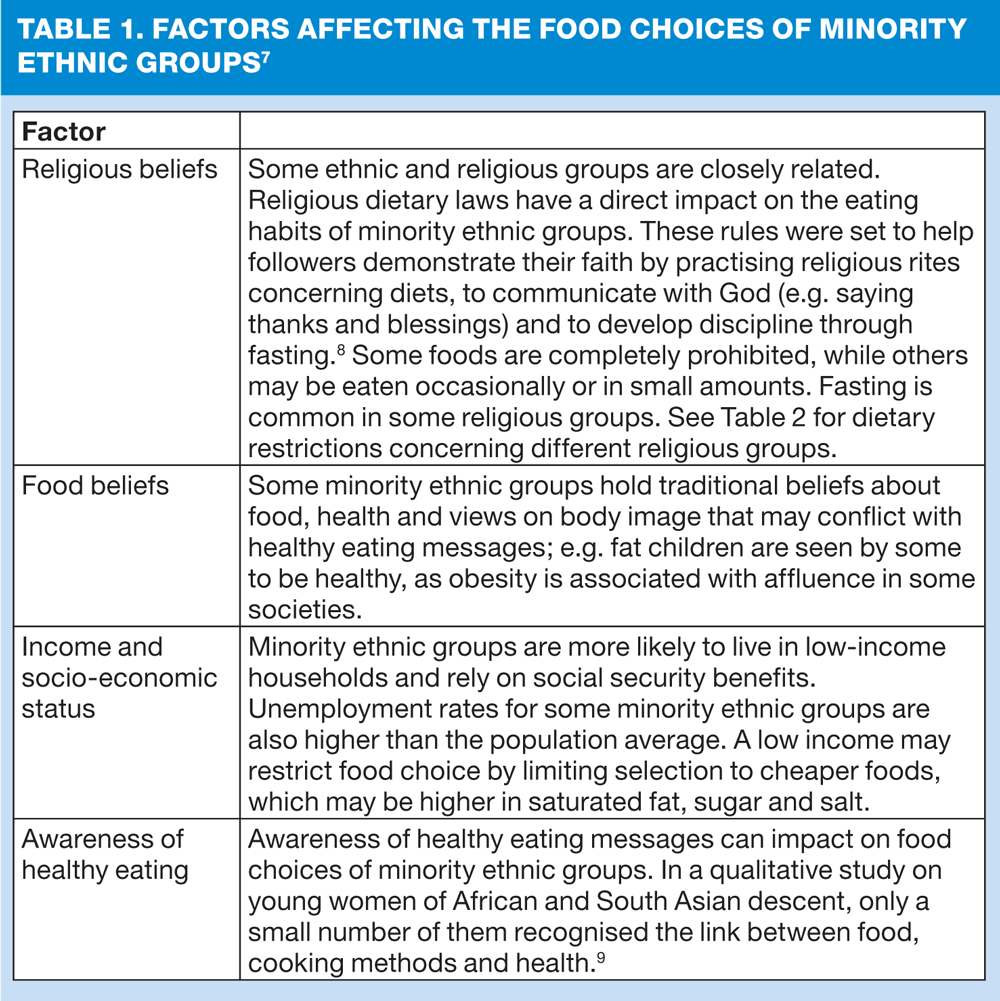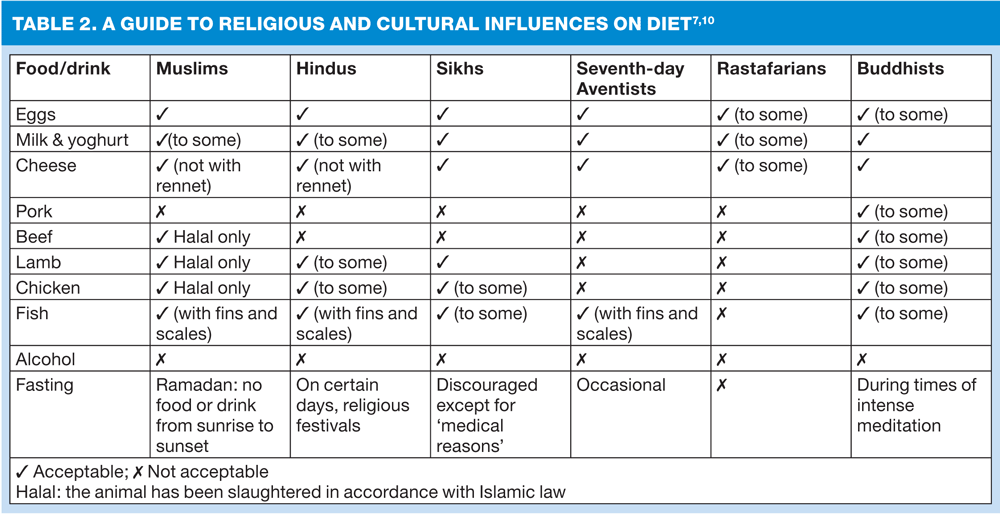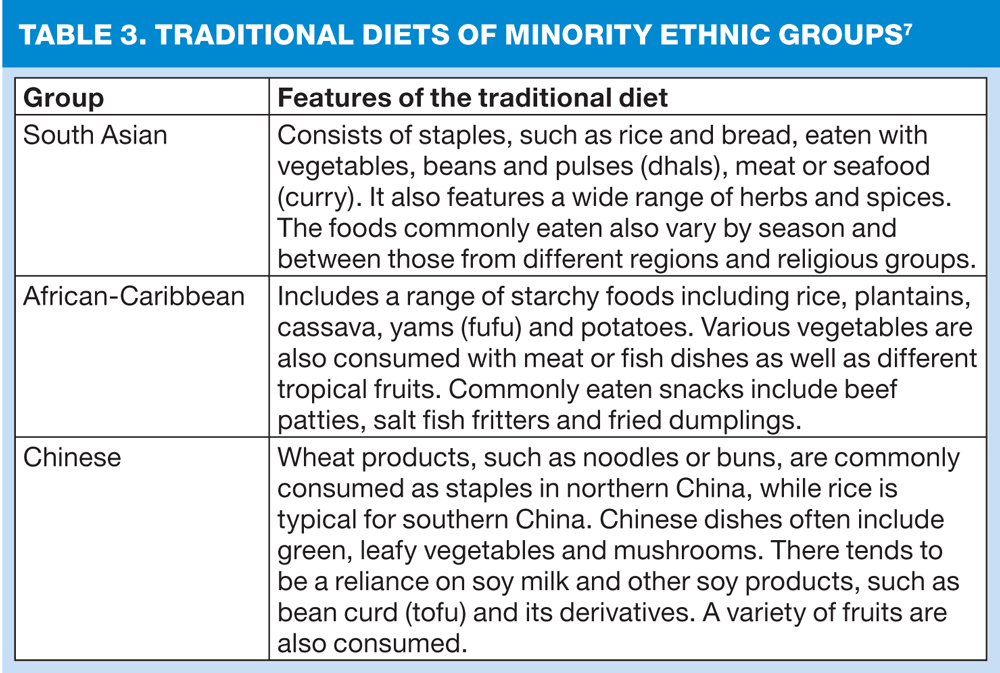Health impact of diet in minority ethnic groups
Georgine Leung
Georgine Leung
BSc, MSc, RNutr (Public Health)
Nutrition Scientist, British Nutrition Foundation
Health status is shaped by a huge array of factors, including diet. Our dietary habits can have a significant impact on our risk of heart disease or type 2 diabetes, and may provide an insight into why some minority ethnic groups are at greater risk of developing these conditions
The UK has a rich mix of cultures and culturally diverse communities, and according to the last census, non-white minority ethnic groups made up 7.9% of the UK's population.1 Studies have shown that some minority ethnic groups are likely to experience poorer health outcomes compared with the mainstream population. These include higher rates of coronary heart disease and stroke, type 2 diabetes and obesity.
The Health Survey for England found that type 2 diabetes was around three to four times more common in Indian, Pakistani and Bangladeshi men, while the condition was more than six times as common among Pakistani women than the mainstream population in 2004.2 The risk of developing type 2 diabetes for minority ethnic groups is also higher at a younger age (from 25 onwards) compared with the White European population (from 40 onwards).3
CARDIOVASCULAR DISEASE
As we know, cardiovascular disease (CVD) is a major cause of mortality and morbidity in the general population, but even more so among some minority ethnic groups. While total death rates for CVD have fallen in the UK since the early 1970s, the decline has been slower among minority ethnic groups. In Pakistani men, the prevalence of coronary heart disease (CHD) rose from 4.8% to 9.1% between 1999 and 2004.2 Compared with the general population, rates of CHD in Indian, Pakistani and Bangladeshi groups are between 30% and 140% higher for men and 50% and 90% higher for women. Black Africans have the lowest risk of CHD of any of the minority ethnic groups.
The increased prevalence of CHD among minority ethnic group adults can be traced back to childhhood. Findings from the Child Heart and Health Study in England (CHASE), which examined the health of around 5,000 primary schoolchildren of different social and ethnic backgrounds (including those of South Asian, Black African and Caribbean origin) from London, Birmingham and Leicester, found that compared with White European children, Black African children had lower LDL-cholesterol levels, while Caribbean and South Asian children had similar or higher levels, which may predict risk differences in later life.5
People of African-Caribbean descent are more likely to suffer from stroke compared with the general population. The risk of hypertension is 20—40% higher in men from this group, and even greater in African-Caribbean women, 60—70% higher than the general population.2
One of the risk factors for CVD is obesity. Obesity rates differ between minority ethnic groups, but women from Bangladeshi, Black Caribbean and Pakistani groups are more likely to have central obesity, defined by a waist-hip ratio of ≥0.85, which is closely associated with insulin resistance, metabolic syndrome, CVD and type 2 diabetes.
It has also been suggested that obesity cut off points used to define overweight and obesity should be lower for Asian groups (including South Asians and the Chinese) as they tend to have a higher body fat content for a given Body Mass Index (BMI) compared with the White European population.4
DIETARY RESTRICTIONS
Some minority ethnic groups are also at risk of low iron status (especially women), likely due to dietary restrictions. Anaemia is more common in both adults and children in these groups compared with the mainstream population. Vitamin D, which is predominantly made in the skin through exposure to sunlight, is important for bone health as it is needed for calcium absorption. However, vitamin D deficiency has been observed in some minority ethnic groups in the UK, such as South Asians and Black African-Caribbeans, particularly in the winter months. This may be due both to having darker skin and wearing concealing clothing.
As is the case for the rest of the population, the dietary habits of minority ethnic groups are affected by a wide variety of factors (Tables 1 and 2). Acquiring a better understanding of these and aspects of their traditional diets (Table 3) can help practice nurses to recognise the needs of these groups and encourage healthier food choices.
To ensure advice and interventions are appropriate, health professionals need to understand the cultural concerns of each minority ethnic group and their subgroups. For example, while it is well known that Muslims fast during Ramadan, it may be less well known that fasting is also practised by Hindus (see Table 2).
Fasting for Muslims during Ramadan poses a particular challenge for patients with diabetes, because of the effect on blood glucose of long periods of abstinence from food and water.6 It is good practice to invite Muslim patients with diabetes for a pre-Ramadan assessment, and to take the opportunity to educate patients on healthy eating during fasting periods, as well as to review medication needs. Because some other religious groups fast on different levels and occasions, health professionals should gain a thorough understanding of their patients' religious and cultural background before providing advice.
If you require further healthy eating information and free education resources for patients, please visit:
www.nurtrition.org.uk
www.foodafactoflife.org.uk
Adapted from 'Diets of minority ethnic groups: implications on chronic disease risk and implications for prevention,' a British Nutrition Foundation briefing paper published in the Nutrition Bulletin, available at: http://onlinelibrary.wiley.com/doi/10.1111/j.1467-3010.2011.01889.x/abstract
REFERENCES
1. Office for National Statistics. Focus on Ethnicity and Identity. 2005 Available at: http://www.ons.gov.uk/
2. Health and Social Care Information Centre Cardiovascular disease and diabetes. In: Health Survey for England 2004: The Health of Minority Ethnic Groups. Available at: http://www.hscic.gov.uk/catalogue/PUB01209
3. Diabetes UK (2006) Causes and risk factors. Available at: http://www.diabetes.org.uk/Guide-to-diabetes/Introduction-to-diabetes/Causes_and_Risk_Factors/ (accessed November 2013).
4. WHO Expert Consultation. Appropriate body-mass index for Asian populations and its implications for policy and intervention strategies. Lancet 2004;363: 157—63.
5. Donin AS, Nightingale CM, Owen CG et al. (2010) Ethnic differences in blood lipids and dietary intake between UK children of black African, black Caribbean, South Asian, and white European origin: the Child Heart and Health Study in England (CHASE). Am J Clin Nutrit 2010;92:776—83.
6. Warren E. Preparing Muslim patients with diabetes for Ramadan. Practice Nurse 27 April 2012;42(07);14-18
7. Leung G, Stanner S. Diets of minority ethnic groups in the UK: influence on chronic disease risk and implications for prevention Nutrition Bulletin 2011;36:161-98.
8. Kearney J, Thomas J, Haddad L. Food and nutrient patterns. In: Human Nutrition, 11th edn (C Geissler, H Powers eds), pp. 3—24. London; Elsevier: 2005
9.Lawrence JM, Devlin E, Macaskill S, et al. Factors that affect the food choices made by girls and young women, from minority ethnic groups, living in the UK. Journal of Human Nutrition and Dietetics 2007;20:311—9.
10. de Wet M, Jean-Marie S, Nelson J, et al. Food and Culture. 1995. Community Nutrition Group Information
Related articles
View all Articles


